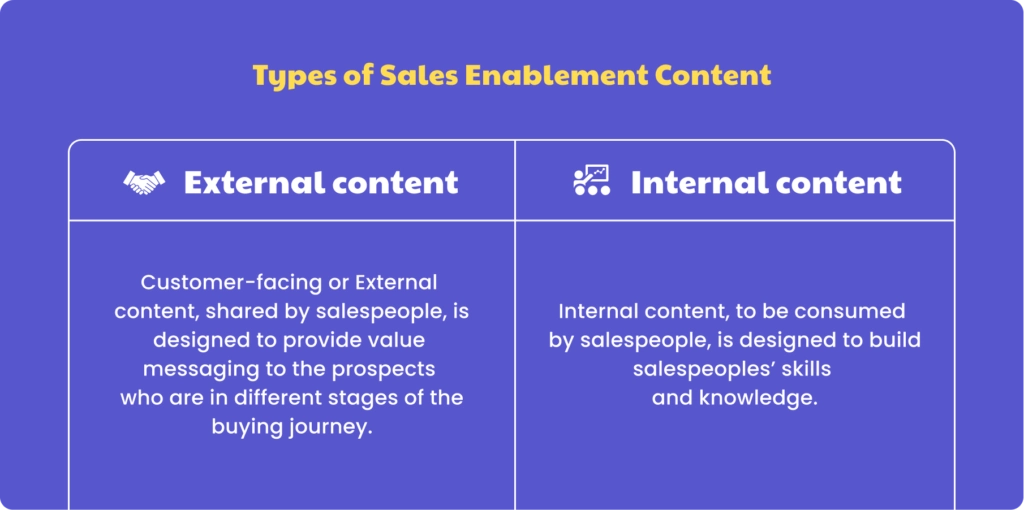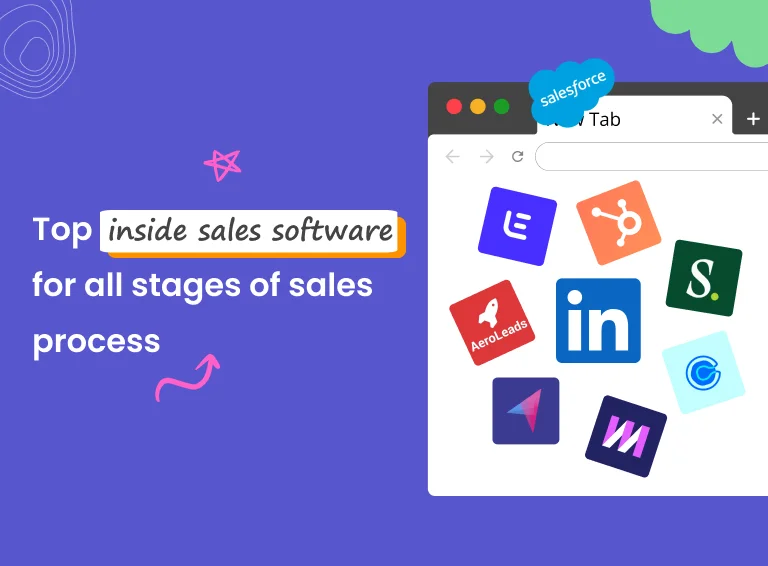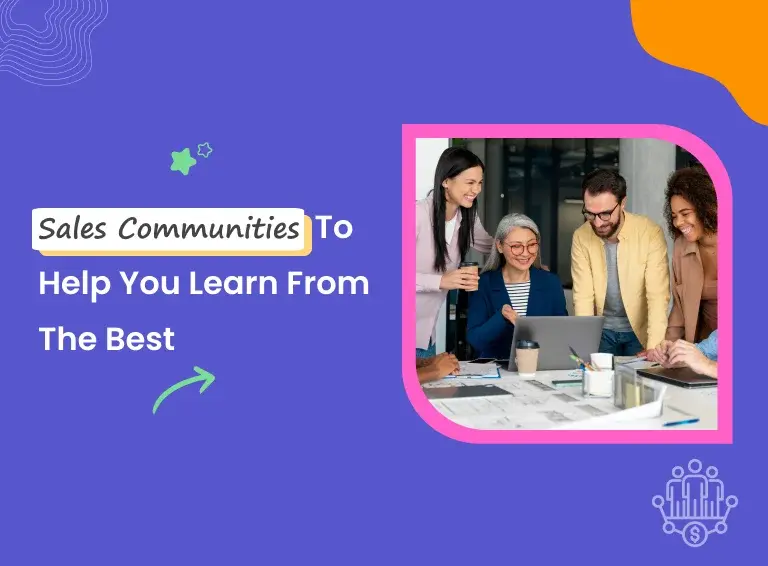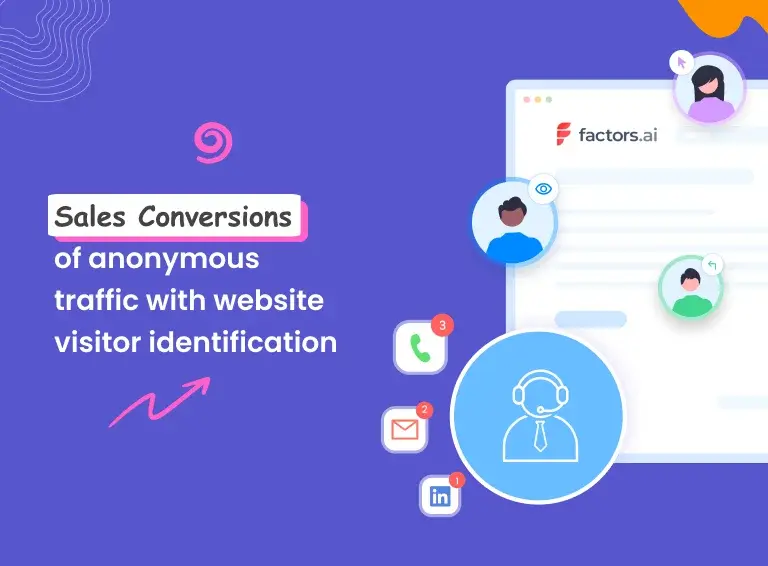The Bard famously wrote —
Some are born great,
Some achieve greatness,
And some have greatness thrust upon them.
It’s as if he were speaking to the modern sales supervisor. Because if you’ve ever managed a sales team, you know that —
Some reps are great at their trade.
Some achieve greatness with practice.
And some have greatness thrust upon them (with support from the company).
After all, not every rep can be a star performer. If you were to take Pareto’s word for it, 20% of your top performers probably rake in 80% of your revenue. Now imagine if the bottom 80% could perform just half as well.
Company support is like a rare tonic. It gives your average Joes and late bloomers superpowers to engage with prospects better and close more deals. We call this support – sales enablement.
In this blog, we give you a pocket guide on how to create sales enablement content that caters to your sales teams' needs, and 24 examples of content assets that you can recreate.
What is sales enablement?
“Sales enablement is all about getting sales faster and quicker, and about winning more deals. It’s multifaceted, and while sales training and sales ops are a part of the equation, content is the biggest bulk of it. Getting the right content to the right audience requires more than just slapping together a blog or a white paper; it also includes the sales decks and demo scripts that are so instrumental to sales professionals,” the founder of a sales enablement company, Gaurav Harode, told Forbes.
Sales enablement is a multi-pronged function pulling in teams from sales ops, marketing, and sales to develop and execute training, coaching, and sales enabling content services and taking care of operational elements of sales like evaluating tools, and strategies. But in this blog, we will only talk about one thing – content services.
In one of the very few books written on Sales Enablement, Byron Matthews and Tamara Schenk explained that sales enablement content are of two kinds.
Sales enablement content types:

Customer-facing or External content, shared by salespeople, is designed to provide value messaging to the prospects who are in different stages of the buying journey.
Example: Whitepapers, Product Demos, ROI templates, Case Studies.
Internal content, to be consumed by salespeople, is designed to build salespeoples’ skills and knowledge.
Example: Cold Email/Cold Calling, Cold Email Templates, Sales Playbooks, Battle cards, Buyer Personas.
What is ‘Value Messaging’?
Value Messaging means the content you share with prospects should be tailored specifically to meet the needs of the main stakeholders in each stage of the buying process — the user of the tool, the manager, and a top-level executive.
For example: Say you sell contract management software. Your rep has been following up after a demo with the prospect – who is a quota-carrying salesperson. But since the demo, your rep has been talking to the sales manager – who has been identified as the ‘influencer’ in the buying process. So, understanding that the buyer, who at this stage is the sales manager, is currently in the evaluation stage of their buyer journey, the rep should ideally send a competitor analysis spec sheet in a bid to handle any future objections rising over competitor features. This ensures that the prospect receives the right message at the right time. Easier, yes? Now the prospect wouldn’t have to send one more mail regarding their doubts on your product’s USP.
Why is it called sales enablement and not content marketing?
Because of all the content strategy and creation that make up a good chunk of the sales enablement function, naturally, it can be confused with content marketing.
Here’s how it’s different:
Content marketing: “Content marketing is a strategic marketing approach focused on creating and distributing valuable, relevant, and consistent content to attract and retain a clearly-defined audience — and, ultimately, to drive profitable customer action,” as defined by the Content Marketing Institute.
Content marketing can be measured by the increase in organic traffic to your website, increase in your MQLs, growth in your email subscriber count, etc.
Sales enablement content: Meanwhile, sales enablement content is made for the salespeople and the prospects. Sales enablement content ensures your reps know how to deliver high-quality interactions with prospects, and are equipped with the right material to send to prospects at whichever stage of the buying process they are in.
The effectiveness of sales enablement content is usually measured by the number of deals closed, length of the sales cycle, win rate, etc.
How should you design your sales enablement content strategy?
Phase 1: Identify gaps in the content your sales teams currently have. Here are some questions you can ask to identify the gaps.
- What are the different types of content your reps currently have access to, and share with prospects?
- Do you provide what prospects want? Or is there a gap?
These questions will help you assess the quality of your current content assets –whether it is actually useful for the prospects, and if it’s easily accessible by your reps.
Once you’ve identified the gap in information, you have a starting point to create your content.
Phase 2: Find out your salespeople’s pain points
Imagine there’s an endless list of top-of-the-funnel blogs, months-old presentation decks, cold calling scripts, some copied and pasted email templates, and attractive whitepapers, scattered across google docs, sheets, and email inboxes, that were written originally by marketing for lead generation.
This means:
- The content is not easily accessible for sales reps. Reps will have to sift through loads of unnecessary content located in company blog pages or within the marketing department first before getting to what they actually want, which takes time.
- Salespeople unable to find the right content for the right prospect. Salespeople engage with prospects at different stages of the buyer journey. Therefore, they’re most likely to look for content that answers a specific pain point common among prospects who are at a particular stage in their buyer journey. For example: If a prospect is negotiating for a lesser price point, Account Executives should be able to give them a case study similar to the prospects’ use-case to reiterate the product’s value to the prospect.
Phase 3: Create content assets
So, for easier access, and increased effectiveness of the content for salespeople, your sales enablement content should be created to suit customer needs at different stages of their buyer journey.
Design your broader sales enablement content strategy according to a prospect’s Buyer Journey.
24 Sales Enablement Content Assets
We will now break down examples of the different sales enablement content assets you can make. But for easier understanding, we will break down the content into three broad categories that are characterized by its direct benefits:
- To onboard reps quickly: Onboard employees into the organization with a primer on the product, the industry and the existing sales and marketing strategies. This will include onboarding playbooks, training documents like – industry playbooks, sales playbooks, quizzes, new employees FAQs, cold calling, cold emailing and objection handling scripts.
- To improve rep productivity: Measuring reps’ performance with metrics and KPIs to help improve their productivity. Help them refine their skills by supporting them with scripts, objections handling battle cards, question maps etc.
- To engage prospects: Educating prospects about the value of the product and driving your unique selling point with clarity by retaining their attention. This will include buying guides, competitor analysis, ebooks, infographics, case studies, white papers, research papers, testimonials etc. It is especially important to have a well-stocked content library – to be able to add value to all the messages you send to prospects over long sales cycles.
Here is a collection of the assets you can have in your sales enablement content library.
To onboard reps quickly
1. FAQs
A list of essential questions about the company, product, industry, and prospects that new employees may ask at the time of joining. These nuggets of information can save a lot of time by anticipating and answering pointed questions from new hires.
2. New hire onboarding checklist
A checklist template on the essentials of onboarding a fresh or experienced sales rep. This is essential to ensure the rep is able to place calls or send emails from day 2. Here’s a sample onboarding checklist by mapmycustomers in the 30-60-90 days model, where expectations are set for the first 30 days, the first 60 days, and the first 90 days.
To know more on creating the sales onboarding checklist for 30,60 and 90 days, go here.
3. Buyer Persona document
Perhaps someday we’ll be able to simulate sales conversations with intelligent, life-like hologram projections of prospective buyers. But until then, reps must use their imagination and a nifty little tool we call the buyer persona for practice.
Take the following one for example. It’s a detailed profile that takes into account the buyer’s business and personal interests. A detailed buyer persona prepares reps to preempt any questions, tackle their pain points with focused consideration, and customize their spiel for each individual. Reps can practice opening the conversation in different ways and finding impactful segues if they already know which kind of person is on the other end of the call or email.
4. Training course
A training course during onboarding sets the tone for what is expected of the reps. Training programs come in the form of live classroom-like courses, workshops, or seminars that award certification at the end.
Introduction to Sales from GoSkills is a great introductory course for new hires. It covers
- Sales techniques
- Sample script outlines
- Establishing credibility in the product
- Cultivating the right attitude
- Identifying clients and their personalities
- Delivering compelling presentations
- Building relationships with prospects
- Follow up strategies
- Closing the deal
5. Training videos
Don’t have the time or resources for a full-fledged training program? Training videos are the next best alternative. Create a set of videos new hires can watch within a defined timeline. They double up as reference material each time a rep needs to brush up on their basics.
Check out this excellent video, for example, on the best data-driven sales techniques like the whiteboard pitch, disqualification, making two-way conversations, and slowing down objections.
6. Quizzes
You’d do whatever it takes to keep a prospect’s attention during a sales cycle. Why not show new reps a glimpse of this during onboarding? Engage them with quizzes that keep them on their toes, and show you how your training program is faring. This will help you understand if they’ve been absorbing the content in the training program.
Wondering how to create a training quiz for your new hires? Have a look at this free sales quiz
7. Call Scripts
Sales calls, cold calling in particular, can keep reps up at night. Agreed, it’s not the most pleasant interaction to have – they have to contact and keep the attention of (mostly) reluctant leads. But it has to be done.
So create and store a couple of scripts that can be used for the different prospects.
Sample Script:
Hi James, it’s Mike with Sky Securities.
I noticed that you took part in a webinar on Digital Security Solutions last Wednesday, is digital security an area of concern for you?
Because the webinar really brought to light how the rise in financial cybercrime is posing a huge threat to businesses like yours and big players like ANV are already pouring millions of dollars into building robust security structures.
But wouldn’t that much investment be a struggle for an establishment of your size?
(Pause and wait for the prospect’s response)
“Yeah, a lot of our clients, too, faced this problem. I’m curious, would it be okay if I dig deeper into the situation and see where exactly we can help you?”
“Great! Tell me, Mike…”
Related: 27 battle-tested cold calling scripts to Handle Different Selling Situations
To improve reps’ productivity
Did you know that having a sales enablement function can increase rep training effectiveness by 29%? In other words, sales enablement makes your reps more productive. And these collaterals play a big role in doing that –
1. Question Maps
Jot down the different questions/responses reps can ask or say in various stages of the cold call or a discovery call. Keeping a question map handy is essential because no conversation with a prospect is going to go according to the script. It will diverge at some point, in all probability, earlier than expected. In such a situation the map will help reps be prepared for any kind of scenario.
Here’s an example of questions that can possibly be asked during a cold call. A similar question map could be made for discovery calls as well.
2. Battle cards
Battle cards are cheat sheets with talking points that can come in handy for reps mid-conversation. The subject of your battle cards can be FAQs, common objections, statistics, and social proof to strengthen arguments and value propositions.
Check out these battle cards from CompeteIQ that can compare features with competitors, trace trends, and include surveys.
3. Scorecards
Individual rep scorecards contain KPIs to track their progress. Logging their milestones right from the time of onboarding gives you an opportunity to course-correct new hires early and keep tabs on their reps’ performance in the long run.
Take these scorecards for example. They track rep-to-team comparisons, time-to- metrics and the effectiveness of onboarding and training programs.
4. Demo Videos
This is where you get to strut your stuff. Demo videos are critical to the sales process because they give your buyer a look and feel of the product before they can make a decision. This demo video is a clean, simple, and self-explaining walkthrough of the product’s user interface.
Videos are a great way to keep your prospects engaged throughout the sales process. Asking to watch a video is not a big of a commitment, and grabs attention.
(Source: https://www.youtube.com/watch?v=vAFz8YTgANI)
5. Playbooks
A good sales playbook can be a bible in the hands of any rep. Playbooks are blueprints of well-established sales processes or methodologies. It’s a compilation of all essential collaterals reps can use at any time in the sales process.. Playbooks can be made for cold calling scripts, lead qualification questions, buyer personas, email templates, sales cadences, or even an end-to-end sales process.Z
This playbook from HP makes no bones about virtual reality use cases, sales tips, and handling objections commonly raised against its adoption.
(Source: HP VR Sales Book )
6. Strategy Scorecards
Sales teams are abuzz with talk of so many KPIs that it can be hard to track. Strategy or balanced scorecards give you a snapshot of the company’s operational measures like innovation, improvement, customer satisfaction, and internal activities, along with its financial metrics. It helps you improve a number of objectives like increasing the average deal size and revenue while also helping audit existing sales enablement assets.
(source: https://www.demandmetric.com/content/sales-enablement-strategy-scorecard)
To guide/engage prospects
High-quality customer-facing sales enablement content is created after anticipating prospects’ questions and needs in advance. These can be used at every step of the buyer's journey to dispel doubts.
The goal of making customer-facing content is to engage the prospects effectively and move them along their buyer journey quickly. That means reps need to be armed with the right content to be sent to the right prospect at the right time.
We have segregated customer-facing sales enablement by the main stages of the buyer journey which includes – A) The Awareness Stage, B) The Consideration Stage
A) The Awareness Stage:
1. Blogs
A blog that can answer all the questions in the mind of a reader is a potent asset for lead generation.
Blog posts should be informative, insightful, entertaining, and capable of driving traffic to your website. Moreover, a blog’s interface should follow the UI design tips and be accessible on mobile devices in order to reach a broader audience.
This blog from a digital product design platform deals with all areas of interest to UI/UX and product designers. It features something for each type of designer or management — from industry trends, strategy and execution, and ideas on leadership to simple how-to-videos, design news, and designs for inspiration.
2. Buying Guides
Buying guides are customer education tools that make your product appealing and simplify the buying process for customers. An effective buying guide is easy to read and navigate and includes products specifications, testimonials and comparisons to similar products.
ArchiExpo has created comprehensive buying guides for every piece of furniture, appliance and fittings conceivable. It’s guide on choosing the right insulation for a building includes —
- How to choose the right insulation
- Everyone one needs to know about the performance of insulation
- Where it can be installed
- Formats and materials
- Options available to the customer
3. Ebooks
Nothing evokes authority like a thick-spined, well-thumbed book. But when business happens on digital channels, ebooks can command similar respect for your product. Other than the optics of it, an ebook is a great asset because it has the potential to answer exactly what the prospects want to know with research-backed data. In-depth studies, explainers, actionable insights, strategy breakdowns, e-books can be a treasure trove of information for prospects.
Here’s one that makes for a compelling read, thanks to the terrific use of visuals interspersed with readable chunks of text.
(Source: Content Marketing Institute)
4. Infographics
A picture is worth a thousand words. When used as an infographic, it makes bland concepts and dry statistics more palatable and easier to understand.
Here’s one that’s hard to take your eyes off of. It shows the amount of information created on different marketing platforms every minute of the day. The colors and symmetry are unforgettable, while the information is conveyed clearly.
5. Brochures
Brochures are staples among sales enablement documents. Whether you choose a classic trifold or go for something more digitally appealing, brochures can convey information about the company and the product succinctly.
Check out this interactive digital brochure from Global Payments for inspiration
6. Newsletters
Station your company leadership as thought leaders in the industry with regular email newsletters. But unless you make your newsletter really compelling, it could just be another email to ignore for subscribers.
Take this newsletter from Statista, for example. It puts a fresh spin on dull and dry data.
7. Podcast
Podcasts are perfect for audiences in this age of short attention spans. They don't require undivided attention, and yet can be incredibly engaging. Make them part of your sales enablement portfolio to share your expertise and brand message to stand apart from your competitors.
An AI video podcast can take this a step further by combining audio, visuals, and intelligent automation—making your content more dynamic, personalized, and scalable.
Facebook’s Boost My Business podcast hosts unexpected pairs of business owners in conversation about opportunities and business transformation. The podcast comes at a time when Facebook attempts to become a go-to platform for businesses. It’s a good example of tailoring sales enablement content to suit changing business goals.
Check it out here
B) The Consideration Stage
8. Case studies
Case studies tell stories. More importantly, they show your prospects exactly how you solved a similar problem for another company successfully.
This case study from Bitly drives the point home by listing the challenges and goals in tracking omnichannel digital marketing campaign results in one place, and how it solved the problem.
(source: https://docsend.com/view/hqwgipx)
9. Testimonials
Nothing can seal the fate of a sale like hearing about the product straight from the horse’s mouth. This is why testimonials are important. Check out this testimonial for Zoom from actor Zachary Quinto.
What’s so good about it? First, is the star factor. But not every company can get somebody famous to give a testimonial. Regardless, this video covers the many functions of Zoom using a very niche example in a clean, no-nonsense format.
10. White papers
White papers are documents used to promote your product or service to convince prospects or ease their decision-making. These documents are different from brochures because they house factual and research-based information in solving prospects’ problems rather than copywriting gibberish.
White papers are useful in positioning a company as a thought leader. They help establish your reliability and experience in the industry by helping prospects understand their problems, new opportunities and solutions.
Here’s a white paper on the future of digital agencies put together by the Digital Agency Network. Insights from 36 diverse leaders in the space make it worth your while.
11. Product Comparison pages
Any serious buyer will compare your product with your competitors’ before making their decision. Use this to your advantage by making comparison pages on your own website that leave them hankering for your product.
The note-taking software Notion has an attractive comparison page with Evernote, its biggest competitor in the space. It includes Notion’s features that can best its rival, a segment on pricing, and even importing files from Evernote!
Measuring effectiveness of sales enablement content
Sales enablement content collaterals tend to be extremely easy to track and measure. Whether through likes and shares on social media, website traffic or newsletter open rates – audience engagement trends can tell you if you’re doing something right.
An example of tracking engagement in social media would be through an Instagram engagement calculator.
To actually track the effectiveness of your sales enablement collaterals, you can track KPIs.
KPIs for new reps
How are your freshly onboarded reps using training and instructional collaterals like scoreboards, buyers personas, courses and videos? Keep tabs on these metrics to judge their performance —
- Product knowledge
- Industry knowledge
- Competitor analysis
- Webinars, recorded demo videos, product
- Number of calls made
- Number of emails written
- Number of opportunities opened
Metrics to track effectiveness of content
Few collaterals will have the desired effects right off the bat. Content engagement metrics help you understand why. To adjust your sales collaterals for more impact, track the following KPIs —
- Bounce rates for the amount of time people spend on webpages
- Scroll depth to see how much your audience is reading
- Email open rates for whether your newsletters are being read
- Quality of website traffic, whether from social media or web search
- Session durations for the amount of time spent on your website
KPIs for better rep productivity
Understand how your reps are utilizing sales collaterals in the long run and its impact on the results with these KPIs and metrics —
- Quota attainment to see if reps are meeting their quota with the resources
- Time to revenue for the time taken to close sales
- Sales funnel transition rates for how quickly they’re advancing from one sales stage to another
- Average win rate for the number of deals closed compared to those lost
- Time spent selling for productivity in engaging the prospect with the sales content.
A range of tools are available in the market today to measure the impact of your sales enablement collaterals. Check out Paperflite, Highspot, and Seismic to find out how you can optimize your sales enablement content for more efficiency.
Final word
These are the best of times for educating and persuading prospects, thanks to the sheer number of resources available. They are also the worst of times because of an unprecedented information overload, leaving companies vying for a fraction of customers’ attention.
That’s why sales enablement collaterals can make or break your deals. Having the right kind of content exactly when your prospect is looking for it can be the difference between a won and lost deal.
Keep an eye on what your prospects need, create content that showcases the value of your product in different use cases, and quantifiable metrics that prospects care about, and craft a sales enablement content strategy that works best for you.





